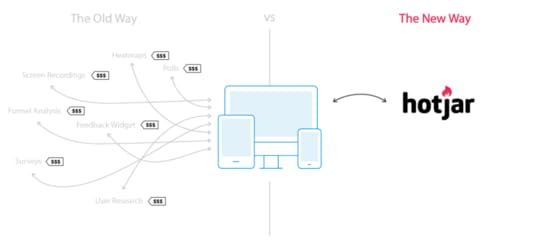Marcu Taylor's Blog, page 16
July 27, 2018
Hotjar Review: Where it shines (and err… where it doesn’t)
Hotjar is one of the more recent analytics tools designed to help marketers better understand their users. Considering the company only started in 2014 and secured its first customer in 2015, Hotjar’s rapid growth over the past few years shows how popular this tool has become.
We also use Hotjar at Venture Harbour, so we’re in a good position to provide some impartial insights into what it can do.
In this review, we’re going to look at where Hotjar shines (and where it doesn’t) to help you decide whether it has a place in your analytics and CRO toolkit.
What does Hotjar have to offer?
Hotjar calls itself an “all-in-one analytics and feedback” that aims to help you understand what visitors are getting up to on your website. Hotjar’s key selling point is that it combines a range of essential analytics features with user feedback tools into a single platform.
Before Hotjar, you needed multiple software platforms to get this combination of features, each one increasing the cost and complexity of your CRO toolkit. Hotjar crams a serious amount of analytics, CRO and user feedback functionality into one, reasonably priced platform.
By now you’re probably wondering what this list of features looks like, so here’s a quick run-down before we look at each of them in more detail:
Heatmaps: Show where users scroll and click or tap on your pages.
Visitor recordings: Video recordings of user sessions so you can see exactly what they’re getting up to.
Conversion funnels: Tell you where users are dropping off along your sales funnels.
Form analysis: Shows you how users are interacting with your forms to help you reduce failed completions.
Feedback polls: Allow you to ask users why they have/haven’t taken a certain action.
Incoming feedback: Lets users leave feedback on your website or app, telling you what they love, hate or feel indifferent about.
Surveys: Reach out to users with feedback forms asking for their input.
Recruit testers: Choose participants to take part in user testing on your site.
That gives you an idea of what Hotjar has to offer but let’s look at each of these features in more detail – so you can see where it shines and where it doesn’t.
Heatmaps – see where users scroll, click and tap
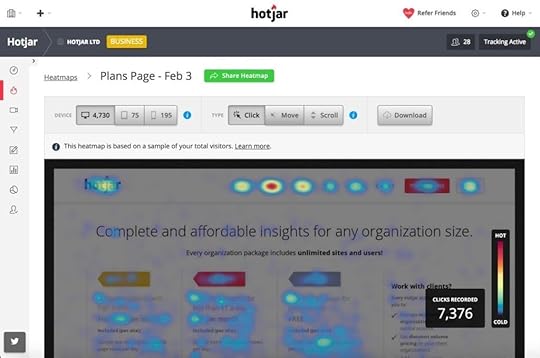
Heatmapping is the essential feature of any user insight tool like Hotjar but how does it compare to rivals like Crazy Egg that offer the same thing? At a glance, the two features look almost identical but you soon realise Hotjar’s heatmaps offer more information.
Unlike CrazyEgg, Hotjar also shows you mouse movements in addition to clicks and you can also see the number of times users have clicked in the same places by hovering over it in the dashboard. You need to go to a different view to get this information on CrazyEgg, which can slow down your workflow.
However, CrazyEgg provides an additional view that breaks down clicks into different categories – something we’d like to see added to Hotjar.
Visitor recordings – see what your users see

Hotjar was one of the first analytics tools to offer visitor recordings, a feature that records the screen of user sessions so you can see exactly what’s going on. CrazyEgg and other tools have since added similar features to their own platforms but Hotjar still edges it.
With user recordings, you can see exactly how users interact with elements on the page: how users scroll, where users move their mouse or touch their mobile screens, etc. You can see the user experience of your website from their perspective and gain a better understanding of what issues are getting in the way.
This is one of Hotjar’s standout out features and a key reason why we love this tool at Venture Harbour.
Conversion funnels – see where your visitors are dropping off
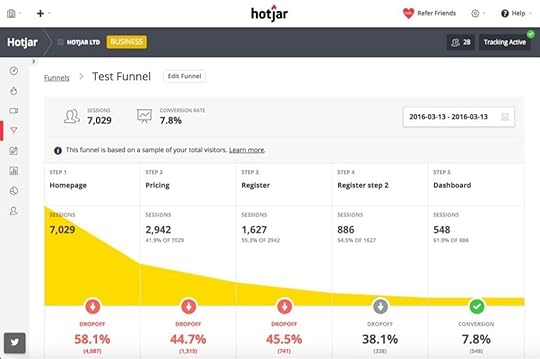
Conversion funnels are a great feature to have, allowing you to see where users are dropping off from the conversion process. Hotjar’s implementation gives you a good starting point to begin your investigations but it’s not an extensive funnel reporting tool by any means.
Expecting Hotjar to match the kind of events and goals analysis we’re doing in Google Analytics would be unrealistic, though. Instead, Hotjar offers a visual overview of where users are dropping off so you can see where to run your next batch of reports.
Form analytics – see where your forms are killing conversions

While it’s great to see Hotjar include form analytics as part of its CRO platform, it doesn’t provide the depth of analysis specialised form analytics tools offer. For example, Formisimo tracks almost 60 metrics to monitor form performance while Hotjar only tracks nine. Hotjar’s reporting isn’t particularly intuitive either – it doesn’t let you split data by date ranges or look at trends by week and month, for example.
Much like Hotjar’s conversion funnel reports, its form analytics can give you a general overview of performance but it doesn’t go far enough to help you pinpoint the cause of problems and get them fixed asap.
Feedback polls – understand user actions

As mentioned earlier, Hotjar’s key selling point is the combination of analytics and user feedback features – and this is where the platform really shines. First up, you’ve got feedback polls, allowing you to ask users why they do or don’t take specific actions. For example, if a user isn’t hitting the buy button or signing up for our newsletter, you can ask them what’s standing in the way.
Likewise, if someone gives up filling out your form, you can ask them what the problem is directly – an incredible feature.
Incoming feedback
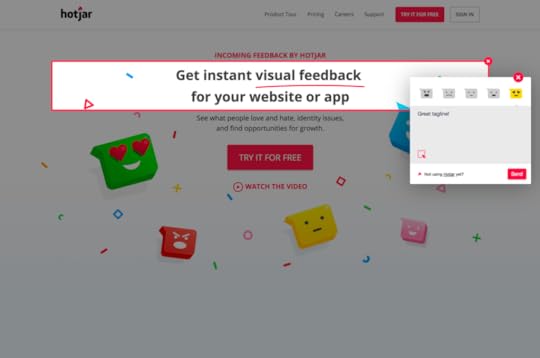
Incoming feedback places a tab or widget on your page, which users can click to leave feedback. This gives people an outlet if they really run into problems and this could save you from losing potential leads. We haven’t really used this feature but it could be an interesting option if you’re struggling to pinpoint a user issue on your site.
Surveys – get to know your audience

Surveys are a crucial part of getting feedback from real users but asking people to provide feedback in a nono-intrusive manner is a real challenge. Hotjar’s invites are about as user-friendly as you could hope for but there’s nothing revolutionary about its designs.
However, the great thing about Hotjar is you can use its analytics features to track the performance of your invites and see how users behave with them. This will tell you if people are struggling to exit your popups on mobile, for example, or if people are initially clicking to provide feedback but giving up before completing it.
Recruit test users

Finally, you can also use Hotjar to recruit users to participate in user testing. This places a widget on your site (as you can see in the image above) asking people to take part. Users simply need to fill out some basic information to sign up and they can also minimise the widget if they want to remove it from view.
Hotjar Verdict
Hotjar’s standout feature is its innovative screen recording capabilities, which you can use to record user sessions and see precisely what’s working and what isn’t. Now, it rivals are starting to release similar features but Hotjar was the first to offer this and combine a range of powerful feedback collection features into a CRO platform.
Impressive stuff.
The only area Hotjar disappoints a little is on the analytics side of things and its form analytics, in particular, doesn’t offer the kind of insights we would like to see. Aside from that, we use Hotjar ourselves and were generally very happy with the results.
The post Hotjar Review: Where it shines (and err… where it doesn’t) appeared first on Venture Harbour.
July 26, 2018
Top 5 Enterprise Email Marketing Automation & CRM Systems
While there are plenty of online articles recommending the best email marketing platforms for small-to-medium size businesses, there’s a shortage of info on the best options for enterprise businesses.
So, in this article, we’re going to help fill the gap by looking at the top five marketing automation and CRM systems for enterprise businesses.
What makes a good enterprise email marketing and CRM platform?
In the SaaS world, enterprise refers to a large business that could have hundreds of employees and thousands of leads to deal with on a monthly basis. Generally speaking, a company with more than 250 employees is considered to be a large enterprise and this is the kind of business enterprise software is designed for.
Unlike smaller businesses, you need a system that your entire sales and marketing team and use seamlessly. You also need a platform that empowers you to handle a large volume of leads and customers and increase the number of leads you’re capable of dealing with as your business grows.
Here are some key things to look out for in enterprise email marketing/CRM software:
Leads/customers: Enterprise tools should allow you to handle high volumes of leads/customers.
User profiles: Check the limit of user profiles you’re able to create.
Automation: These are the features that will help you handle and convert more leads with the same-sized team and budget.
Personalisation: These are the features that help you turn customer data into more effective marketing messages.
Analytics: You want to know how your entire team is performing as a unit and as individuals.
Testing: Built-in testing features should be part of any enterprise email marketing tool.
Priority support: As an enterprise customer you should be first in line for support when you need it.
Dedicated account rep: You should also have a dedicated account rep who is familiar with your business and account, as well as the platform itself.
Integration: You want to make sure your enterprise email marketing/CRM software integrates seamlessly with your other tools.
Templates: Quality is more important than volume and the ability to create, customise and save your own templates is important.
You need all of this in an intuitive platform that your entire team can get to grips with and use to improve sales and marketing results. These are standards we’ve set for the recommendations in this article and here are the five top platforms we think you should pay attention to.
#1: ActiveCampaign

ActiveCampaign is our main email marketing automation and CRM tool – mostly because it covers both tasks so well. Aside from email marketing, you get an extensive collection of sales, marketing and automation features. Email marketing is an important part of our lead generation and nurturing strategy but ActiveCampaign makes it incredibly easy to create sales funnels and manage leads at every stage of the buying process.
Any member of our team can pick up an ongoing lead or customer query and know exactly what’s going on – as well as what needs to happen next. With ActiveCampaign’s lead scoring technology allows us to prioritise our efforts with the most valuable leads and automate solution to turn “cold” leads into something more promising.
As an enterprise tool, ActiveCampaign pretty much ticks every box on our list of requirements and it’s competitively priced against other platforms at this level.
#2: Hubspot

Hubspot is one of the most famous enterprise marketing and CRM platforms in the industry – and one of the first we wanted to try out for ourselves. In terms of features, you’ll do well to find a single solution for analytics, automation and CRM that offers more.
The problem is you have to pay some serious money to get your hands on all of these features – at least $2,400 per month for an enterprise business and probably more.
Don’t get me wrong, there’s nothing wrong with paying this kind of money for a platform that adds enough value to your business to justify the price. But you can get 90% of Hubspot’s features for roughly $250 with ActiveCampaign and get the other 10% by spending $99 on an additional few tools.
If Hubspot did anything better than the other tools we’re using then it might be a different story but it really seems you’re essentially paying for the privilege of having everything integrated into a single platform (sort of).
I say “sort of” because Hubspot is actually four products: Marketing Hub, Sales Hub, Service Hub and a free CRM that all integrate together.

This isn’t as confusing as it might sound and Hubspot’s does a great job of integrating these products into an intuitive platform. Whether this justifies the price for you is something only you can answer but we decided to take a different approach.
#3: Salesforce

Salesforce is a comprehensive CRM platform that puts the emphasis on lead nurturing and customer relationships rather than marketing. In this regard, it’s one of the best dedicated CRMs on the market, offering just about every feature you could possibly need into an extensive range of products that you can customise to meet the needs of your business.
This is the great strength of Salesforce: powerful features that you can essentially add or delete, creating a bespoke CRM platform that does everything you need and nothing else.
The downside to this is that it can take a lot of time to get Salesforce set up the way you need it. In fairness, this is a one-off inconvenience so don’t let this put you off too much. The main concern we had with using Salesforce after a few weeks was that we felt the interface is too clunky and the platform just didn’t seem as intuitive as we had hoped.
We also wanted more emphasis on the email marketing and automation side of things, which isn’t really Salesforce’s priority. If you’re more interested in the CRM aspect than marketing and automation, too, then Salesforce is definitely worth a look.
#4: Infusionsoft

When we first started looking into CRM and automation tools, Infusionsoft was hard to beat. Sure, it’s not the cheapest option but it offered automation features and a campaign builder that left every other platform in its dust. Today, Infusionsoft is still an incredibly powerful platform but it doesn’t have the edge it once did with newer arrivals like ActiveCampaign on the scene.
While the prices are harder to justify (especially those $1,999 training fees for new users) Infusionsoft hasn’t done enough to improve usability for our liking and the platform feels dated from a UX perspective.
Despite being such a powerful piece of kit, Infusionsoft lacked a number of key features we really needed – and would expect at these kinds of prices. Reporting isn’t particularly great, the email templates are mediocre at best and you can’t set up recurring PayPal payments, which was a dealbreaker alone for us.
#5: SendinBlue

Source: SendinBlue Blog
We use SendinBlue to send transactional emails to our customers and this alone makes it an invaluable part of our marketing automation flow. It’s a very affordable tool that combines one of the best email builders we’ve used with email templates that make it easy to get campaigns running quickly.
As an all-round email marketing tools, SendinBlue provides all the essentials you need but it doesn’t offer much in the way of CRM features or reporting. For example, there’s no lead scoring or segmentation and you can’t create invoices or set up recurring payments.
In fact, the list of what SendinBlue can’t do is surprisingly long for a marketing automation tool in today’s industry. We don’t mind this at all, though, because it does such a good job of what it’s designed to do and fits perfectly into our wider automation and CRM system.
With ActiveCampaign and SendinBlue running alongside each other, there isn’t much else we need when it comes to email marketing automation and CRM.
What are you really paying for with enterprise software?
The biggest lesson we learned on our journey of choosing an enterprise email marketing automation system was that you can easily pay over the odds for very little. Price isn’t the only factor by any means – especially at the enterprise level – but you have to begrudge paying thousands per month for something you can get at a fraction of the price with other tools.
At Venture Harbour, we were particularly demanding about usability and getting all the features we needed in a small selection of tools. Your priorities might be slightly different but the ActiveCampaign and SendinBlue combination was the setup that stood out for us – and it also happened to be one of the most affordable.
So make sure you know what you need from an enterprise email marketing automation platform and ask yourself what you’re really paying for.
The post Top 5 Enterprise Email Marketing Automation & CRM Systems appeared first on Venture Harbour.
July 12, 2018
16 Must-Have Conversion Rate Optimisation Software Tools
Today I’m going to run through the must-have conversion rate optimisation tools for any online brand, but this won’t be like most articles you see on this topic. Instead of focusing on the tools themselves, I’m going to flip things around and list the essential CRO tasks you need to complete with a number of tool recommendations along the way.
The reason I’m doing it this way is because most optimisation tools do various tasks, but none of them do it all. So it’s better to know what you need from your toolset before you sign up to anything. This way you can choose the right combination of tools and make sure there are no gaps or unnecessary overlaps in your CRO tech stack.
#1: Google Analytics 360 Suite
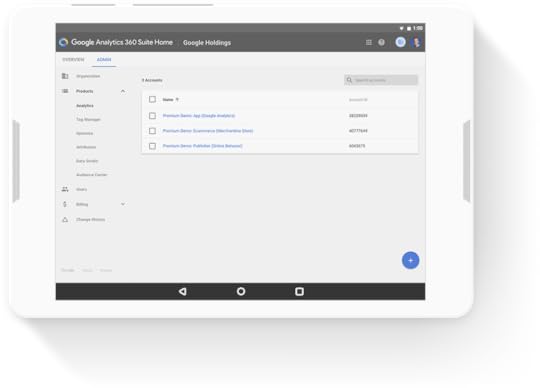
The first conversion optimisation tool any serious business wants to look at is Google Analytics 360 Suite. This is the enterprise version of Google’s powerful analytics tool, giving you access to more data and features to power your marketing strategies.
Conversion optimisation is all about data and this is the first piece of software you want in your stack.
#2: Mixpanel

If Google Analytics tells you what’s happening on your website, Mixpanel makes it easier to see who did what. It also gives you a second data channel for you to compare against Google’s data – because it never makes sense to put all of your faith into one tool.
#3: Iridion
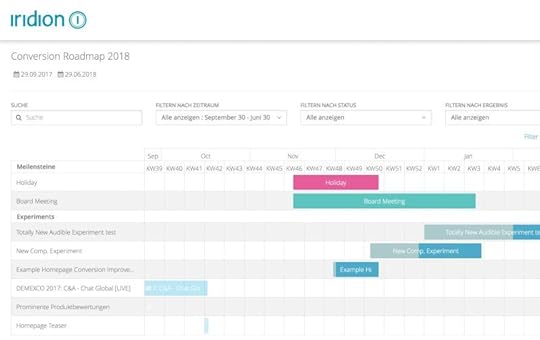
Iridion is like Google Calendar on a serious CRO fix, helping your entire team create and track an entire conversion optimisation strategy. It also packs a 7-level analysis framework to discover new opportunities to optimise for.
#4: VWO
VWO is one of the best A/B testing tools in the game
VWO is a complete conversion optimisation toolkit for brands with a long-term vision for better business performance. You get A/B testing, heatmaps, visitor recordings and all kinds of optimisation tools bundles into this platform – almost everything you’ll ever need for CRO.
More importantly, you get a full overview of your entire conversion optimisation strategy, allowing you to understand its true impact and spot new opportunities.
#5: Marketo

Marketo is still the industry leader in enterprise marketing automation. Automation is vital for maximising conversions while reducing the workload of your marketing and development teams. Instead of optimising for conversions in isolation, automation allows you to close the gaps between different conversion types and turn more leads into sales, repeat customers and brand loyalists.
#5: Instapage

The Enterprise version of Instapage’s landing page builder and optimisation tool is just about the best piece of software in this category. You get full customisability, A/B testing features and dynamic content personalisation all added to the usual landing page builder tools – plus a whole lot more.
#3: ActiveCampaign
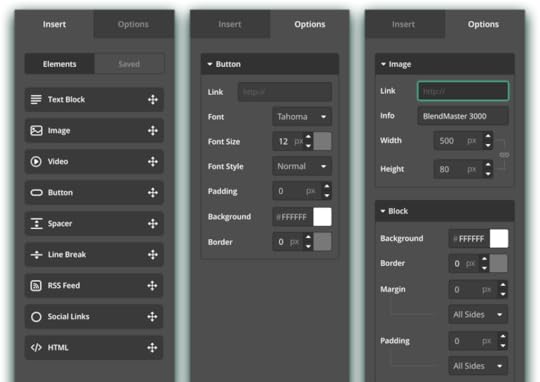
ActiveCampaign is an all-in-one marketing suite that helps you to build email campaigns and nurture leads across the entire buying journey.It packs a host of marketing automation features so you can setup auto-responses for different leads based on their actions. And with its built-in sales and CRM system, you can keep track of all your leads as they work their way along the consumer journey.
#4: Leadformly
Unfortunately, forms are a real conversion killer but there are plenty of optimisation tools you can use to reveal where users are running into problems with your web forms. The reason I like Leadformly is it comes with pre-optimised web forms you can embed on any page and customise without writing any code. Of all the form tools I’ve used, this is by far the quickest way to make a positive impact on your form conversion rates.

How to Acquire 4X More Leads
Attend this FREE online training with Marcus Taylor
Attend this webinar
#6: Optimizely X
Optimizely makes it easy to personalise your content for multiple audiences
Personalisation is the new big trend in conversion optimisation, allowing you to show different messages to users based on their previous actions. For example, first-time visitors can see a completely different homepage to returning visitors and different again to previous visitors who abandoned their shopping cart.
Optimizely X currently offers some of the best personalisation features around but this is one area where new tools are constantly hitting the market.
#7: Decibel
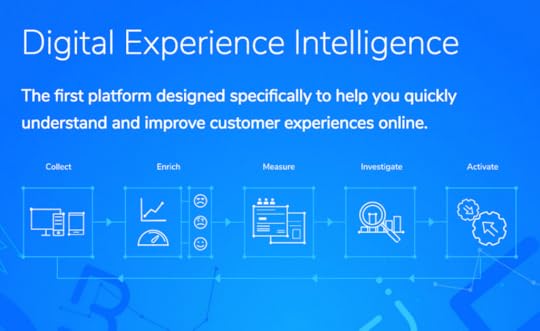
Decibel steps away from the usual dialogue of “conversion optimisation” and focuses on creating better experiences. That might sound ambiguous but Decibel actually measures the performance of your site across hundreds of metrics to calculate your Digital Experience Score (DXS) – an actual KPI that means you can measure user experience in pure numbers.
#8: Ethnio

Ethnio turns user testing on its head by helping you recruit real users to participate in your test. Unlike other platforms attempting to do this, Ethnio lets you choose the right kind of people to test your site and pages – the kind of people you’re actually designing and optimising for.
#9: Infusionsoft
It’s no good generating leads if you don’t have the resources to handle them and platforms like Infusionsoft automate a huge chunk of the process for you. One of its best features from a conversion point of view is automating lead follow-ups with personalised messages for a range of different actions: email sends, form submissions, payment history and more.
As the number of interactions between consumers and brands increases it can be tricky to keep track of where users are long the buying process. With sales automation, you know where everyone is and you have an automated system to send them personalised messages encouraging them to take the next step.
#10: Clicktale
Clicktale is an incredible enterprise analytics and CRO tool
One of the best ways to measure website performance is to see what users get up to while they’re on it. If people aren’t seeing your call-to-action, you know it needs to go somewhere else. If they keep clicking on static elements, you know it’s time to revise the design of your links, buttons and other UI elements.
There are plenty of software options for this but Clicktale is one of the fully-featured enterprise level tools out there.
#11: Pingdom
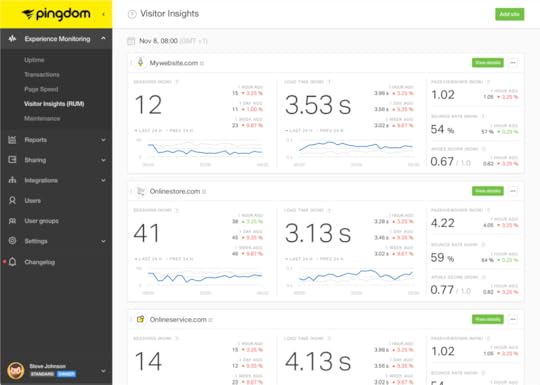
The best tool you can have on your side for speed optimisation is a quality developer who knows how to put code together with performance in mind. However, if your site is already live and lagging behind, you need to diagnose what the problem is.
Pingdom goes further than any of the free options you’ll find, such as Google’s page speed tools (which are fine for free options). However, Pingdom constantly monitors the speed of your site, looking out for issues and helps you diagnose the root cause rather than treating the symptoms.
#12: Browserling

Browserling helps you optimise your site for all the major web browsers and all their intricate quirks. There’s nothing worse than working on your site for months to find your new layout doesn’t work in Firefox or falls apart in Opera when users work in split-screen mode.
With Browserling, you can create a consistent experience across all browsers and devices.
#13: SimilarWeb
Every tool we’ve looked at so far helps you analyse your own site but there’s a lot to be said for learning from your competitors. Competitor analysis tools have been around for ages but Similar Web is the standout option for me right now.
First of all, its pool of data is huge and global (many are US-centric). With this tool you can pinpoint your closest search competitors, based on keyword performance, and it also tells you when new competitors emerge. You get detailed insights into their performance, including number of visits, page views, bounce rate and visit duration – plus audience interests, geolocation details and a whole lot more.
Be efficient with conversion optimisation
It’s easy to get lost in a sea of data and irrelevant tests with conversion rate optimisation, which only ends up wasting time and money for nothing – or worse, causing more harm than good. Conversion rate optimisation only works when it’s efficient and this means choosing the right tools and areas of your site to focus on. Always aim for key areas of your website rather than small details because this is where the real impact will be made and automate as much of the process as you can with your CRO tech stack.
The post 16 Must-Have Conversion Rate Optimisation Software Tools appeared first on Venture Harbour.
July 10, 2018
Has GDPR Killed Personalised Marketing?
The General Data Protection Regulation (GDPR) has been hyped up as a kind of doomsday for data-driven marketing. This is particularly true for personalisation, which relies heavily on user data over various sessions (and devices) to deliver customised experiences.
GDPR doesn’t mean the end for personalised marketing, though. In this article, we’re going to look at how you can deal with GDPR and keep hitting targets with personalisation – and perhaps even improve results.
First, know what you need to do
Hopefully, you’re already GDPR compliant and have been since the deadline passed on May 25 or you could be subject to some of those nasty fines being handed out. Don’t expect any legal advice from this article or rely on us to tell you what your requirements are – get the necessary legal advice, if you haven’t already, and make sure you’re covered.
That being said, there are some important points to keep in mind regarding GDPR and personalised marketing.
GDPR for EU data
GDPR applies to all personal data collected from EU citizens (including the UK after Brexit). This means you don’t need to worry about GDPR for data you collect from outside of the EU but also means companies elsewhere in the world need to be GDPR compliant for any data they collect from EU citizens.
This makes GDPR particularly complex for international companies based outside of the EU. Various sites have simply blocked traffic from the EU since May 25, including a number of major US news publications.
It’s all about personal data
A major part of GDPR is the requirement to get consent from users before collecting any personal data from them. Therefore, it’s important to understand what counts as personal data and what doesn’t.
Essentially, any data that could be used to identify a person or be connected to their identity counts as personal. For example, an email address is tied to a single individual, which means this counts as personal information that requires consent. However, a first name by itself or a person’s location alone can’t be used to identify an individual.
You also need to think about combinations. Collecting someone’s first and last name doesn’t necessarily require consent under GDPR because multiple people around the world can have the same name. If you combine this info with someone’s location data, though, you’re getting very personal and consent is going to be needed.
GDPR vs ePrivacy
In the build-up to May 25, email inboxes were crammed with messages from brands asking users to opt-in in order to keep receiving emails from them. The problem is, many of these brands were confusing GDPR with another set of privacy laws that have been in effect since 2002 – the European Union (EU) ePrivacy Directive.
While GDPR regulates the collection and use of personal data, it’s the ePrivacy Directive that specifies how you can use this data for electronic communications. This is why you can’t send unsolicited emails to people or track users with cookies without getting consent first.
As soon as you use people’s data to sent them marketing messages, you need to comply with GDPR and the ePrivacy Directive.
Getting consent makes or breaks personalisation
Because personalised marketing relies on… well, personal data, you’re going to have to design a consent process that gets people handing over their details. Looking at the GDPR requirements for on consent makes this sound like a difficult mission but studies have shown that over 75% of consumers are happy to share their details with brands they trust.
Source: What Is the Future of Data Sharing? – Consumer Mindsets and the Power of Brands published by David Rogers on Slideshare.
There’s your clue right there: trust. If you make it clear to people that their data is in safe hands and you give them enough incentive to opt-in, GDPR shouldn’t be a personalisation killer for you.
In fact, GDPR could be an opportunity to improve your personalisation efforts and generate more qualified leads – something I’ll talk about in more detail later. For now, though, let’s concentrate on designing a consent process that keeps the data coming in and doesn’t get in the way of conversions.
Getting consent without killing conversions
One of the biggest concerns for marketers with GDPR is that a more complex consent process will add friction and hurt conversion rates. There’s a lot of reason to be cautious about this, too, and many of the consent forms I’ve seen over the past few months make a mockery of all the UX design progress we’ve made in the last decade.
Here’s what you need to do:
First, make sure you’re compliant
Before you design your consent requests, make a list of all your GDPR requirements because the most important thing is to make sure you’re covered. Generally speaking, you want to tick off all the items on your list of requirements while adding the least amount of friction and maintaining the best user experience possible.
Here are some of the requirements you’re going to need to meet:
Active opt-in: Users need to actively opt-in for you to collect their data, which means no more boxes ticked by default.
Prominence: Your consent options should be prominent enough for users to see and, if you’ve got multiple options, they should all be equal in size and prominence.
Clarity: You need to explain what users’ data will be used for clearly and concisely – don’t use any vague, ambiguous or confusing language.
Transparency: You need to name any third-party sources users’ data will be shared with.
Granular: If you’re using data for different purposes, provide multiple opt-in options for users to choose which applications they’re happy with.
This isn’t a complete list of your requirements but it gives you an idea of what you’ll need to consider when designing for consent. As you’ll see in the following points, it’s perfectly possible to be GDPR complaint without killing the user experience of your site or ruining your personalisation strategy.
Build trust and add incentive
There’s no denying that pointing people’s attention to the fact you’re going to use their data and increasing the number actions users need to take while converting is going to put some people off. However, we’ve already established that people are generally willing to hand over reasonable data to brands they trust – so this should be one of your priorities with GDPR.
Make the extra effort to earn user trust across your site and other platforms, especially on the pages and areas where you ask users to submit data.
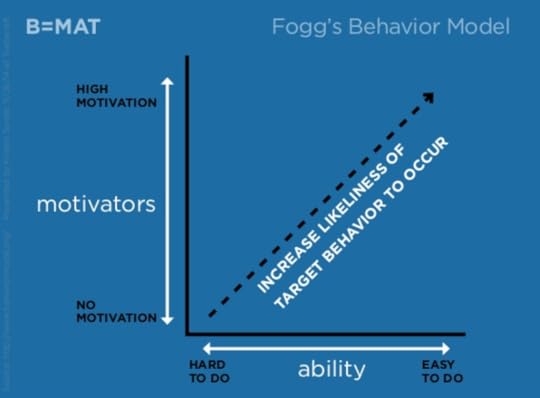
You’ll also want to try and increase incentive (motivation) as much as possible. The more incentive you give people to convert, the less concerned they’ll be about data and the more willing they’ll be to take extra steps during the conversion process.
The multi-form ‘hack’
We’ve mentioned how multi-step forms can boost conversions plenty of times on this blog. Aside from reducing friction, increasing engagement and reducing failed completions, multi-step forms have another powerful trick up their sleeve – and it’s closely related to incentive.
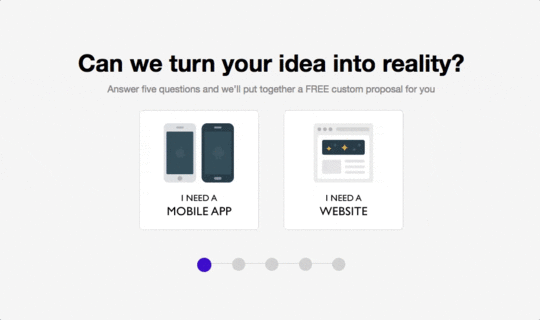
Progress indicators are a standard feature of Leadformly forms, which are designed to maximise conversions.
By adding a progress indicator to your multi-step forms, it becomes increasingly difficult for users to quit the session before converting. This is thanks to a phenomenon known as loss aversion where users feel they’ll lose out on the time they invested in filling out 90% of a form only to quit before converting.
This enhances the incentive that prompts users to start filling out your form in the first place and reduces the negative impact of friction.
So what has this got to do with GDPR?
Well, if you save your opt-ins for the last stage of your multi-step form users know they will have wasted their time filling out the previous stages and it will be difficult to give up at this stage. They were happy enough to type in their data throughout your form until this poperint and not giving you permission to use it at this stage doesn’t make much sense.
Don’t let GDPR kill your personalised marketing strategy
GDPR is a going to make an impact on personalised marketing but it doesn’t have to be a negative one. Studies have shown that most people are willing to submit data to the brands they trust when they understand it’s going to improve the customer experience for them and this is an opportunity for companies and marketers alike to build a stronger sense of trust with their audiences.
The mistake many businesses are making in the early months of GDPR is to block European audiences or design consent requests that kill the user experience – neither of which is necessary.
Focus on providing the best possible experience, explain why users are going to be better off by sharing important data and make sure you keep the incentive at an all-time high. Pull this off and you should end up working with highly qualified leads that appreciate the personalised experience – the kind they’ve been used to getting for half a decade already.
There’s no reason GDPR needs to get in the way of this.
The post Has GDPR Killed Personalised Marketing? appeared first on Venture Harbour.
July 1, 2018
3 Homepage Design Tweaks That Increased Our Conversion Rates By 500%
Your homepage is always one of the trickiest assets of your website to optimise. No other part of your site has so much to do in a relatively short space: present your brand image, push your key selling points, explain exactly what you have to offer and convert users – or at least guide them to another part of your site with more specific information and other opportunities to convert.
That’s a lot to squeeze into a single page and you really have to get the finer details right when it comes to designing a homepage that keeps traffic on your site and generates valuable leads.
To help illustrate how much the finer details matter, we’re going to show you three tweaks we make to our homepage that increased conversions by more than 500%.
#1: Simplifying the hero section

You’ll see all kinds of articles online telling you how to improve the hero section of your site to increase conversions. The problem is they tend to follow the same concept of adding things that will convince people to convert: compelling images, calls-to-action, buttons and everything you’ll find in the typical handbook for conversion optimisation.
Except you’ll often find that simplifying your approach is the better way to go and this is exactly what we encountered when it came to optimising the hero section of our homepage.

While our natural instinct was to push users towards the conversion as soon as possible, we’ve gotten much better reults over time by ditching the CTAs and buttons in favour of a simpler message that communicates our key selling point: accelerating business growth.

By reducing the information load upon users when they land on our homepage and removing the number of required actions (now they only need to scroll for more info), we’ve increased engagement through lower bounce rates and more time spent on page – all of which gives our other messages a better chance to convert without early distractions getting in the way.
As soon as we lifted the CTA from our hero section and replaced it with a more compelling value proposition, we saw email signups from our homepage increase from 11% to 17% (a 55% increase). That’s pretty impressive when all we really did was remove something designed to convert and rethink our message.
Without a CTA in our hero section and a stronger message hitting users when they first land on our page, more users are staying on our page and converting in larger numbers when they reach the calls-to-action further down our homepage.
#2: Switching to multi-step forms

The most significant change we’ve made to the Venture harbour website so far is switching to multi-step forms. Design best practices tell you shorter forms mean less friction and higher conversion rates – a great theory, but one that doesn’t materialise in the wild.
The more we worked with multi-step forms, the more we realised the general consensus on form design didn’t add up. So we switched to multi-step forms and refined our approach until we created an intuitive format using interactive questions and conditional logic to guide users through different conversion types.
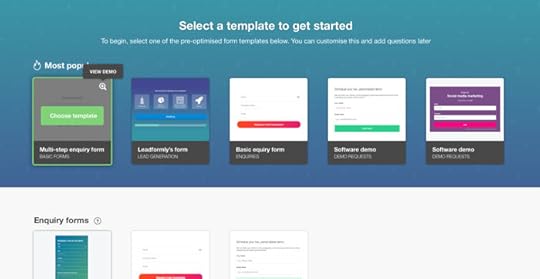
Once we realised the power of multi-step forms we created Leadformly – an advanced form design and analytics tool rolled into one.
Now we can use one form to generate three different types of leads, based on different user needs, without them needing to navigate to different parts of our site and risk getting lost along the way – ideal for a homepage where you have multiple offers to promote.
One our final implementation of multi-step forms was up and running we were looking at an incredible 300% increase in homepage conversions and we’ve seen even better results on other websites we manage. Until this day, moving over to multi-step forms has made the single biggest difference to conversion rates across our site.
#3: Telling stories

Following the same principle behind our new message in the hero section of the Venture Harbour homepage, we adopted a new content strategy of showing visitors the impact we have upon businesses. Instead of selling our services, we tried a number of variations on the traditional case study approach.
By split testing our variations we found the best performer was something we call “stories” which are essentially short case studies – each one with compelling headlines that address one of the top three marketing concerns highlighted in our research.

We also had to split test a number of conversion options to see which got the best results. Our first tactic was to create pages for each case study and place email signups at various sections of each page. Our second option was to use exit-intent popups instead of the email CTAs. Finally, we also tested a variation that bypassed the pages altogether and asked users to hand over their email address right away.
Amazingly, this final variation got the best results.
So we dropped the “Story” pages and prompted users to submit their email address in exchange for our stories. We make a point of highlighting the key takeaways people can expect and establish ourselves as a brand that shares insights with business owners around the world – a theme that now runs throughout the Venture Harbour website.
Through telling stories and sharing our insights – instead of directly promoting our services – we increased our email signups by more than 150% in less than a year.
Minimal changes make an impact
The key to conversion rate optimisation is knowing what to test. You can follow all the UX best practices and test everything in the CRO guidebook but you’ll waste heaps of time and budget switching between endless variations. Every tweak we’ve mentioned in this article breaks some kind of UX or CRO principle but they collectively increased our conversion rates by more than 500%.
We achieved this by focusing on the areas of our site that impact conversions most and forgetting about all the assumptions best practices rely on. We did our research, collected our own user data and made minimal, informed design tweaks that had a serious impact. This is the kind of efficient, high-impact approach to conversion rate optimisation you should be aiming for.
The post 3 Homepage Design Tweaks That Increased Our Conversion Rates By 500% appeared first on Venture Harbour.
June 22, 2018
How to Automate Your Small Business in 5 Simple Steps
Automation is taking the marketing and wider business world by storm, thanks to a new breed of mature algorithmic technology that’s available for everyone to use. Now, brands of all sizes can create their own automated processes to transform their business into a more productive, efficient and – above all – profitable enterprise.
In this article we’re going to run through the five key steps to transforming your business with automation – so you can make 2018 the year you turn this technology into end-of-year reports worth celebrating.
#1: Choose which tasks you’re going to automate
If this sounds obvious or simple, think again. Choosing the right tasks to automate is absolutely crucial and this is where most businesses get off to a false start with automation – so don’t make the same mistake.
First, you need to understand how automation works and what it’s truly capable of because the majority of tasks you can automate, you probably shouldn’t. There are tonnes of tools for automating translation, web design, content writing and everything else you could do as a marketer or business owner – but most of them fall way short of the mark.
Translation technology, for example, is basically useless for most business purposes and it’s difficult to know whether the technology will ever be able to replicate the complex cognitive processes human translators are capable of.
So what kind of tasks should you be automating?
Well, you want to automate tasks that are repetitive, time-consuming and easy for algorithms to handle 100% accurately without your input. Tasks like:
Publishing WordPress posts to Twitter at specific times
Bulk image resizing and optimisation
Analytics reports
Sending invoices once tasks are completed
Scoring leads based on user actions
Automating email responses for different lead scores
Reaching out to existing customer
What you don’t want to try and automate are tasks that require creative thinking and a lot of human input – ie: content creation, design processes or problem solving. Start simple by connecting platforms together with tools like Zapier and IFTTT and aim to take out as many repetitive tasks out of your workflow as possible.
For example, do you really need to import spreadsheets between Excel and Google Sheets six times a day when you could automate this process?
Once you get a feel for what automation can/can’t do you’ll start to come up with some more ambitious strategies that don’t simply save you time and money but transform your business entirely. Before long, you’ll be writing success stories like these:
12 Automation Tools That Save Us £155,000+ on Extra Staff & Freelancers Every Year
Growth on Autopilot: A Healthier Alternative to the Old Way of Business
How to Automate Quotes & Proposals to Capture More Leads
The Ultimate Guide to Automated Evergreen Webinars
#2: Choose your automation tools
Once you know which tasks you’re going to automate, it’s time to choose the tools you’re going to use to make things happen. There are so many automation platforms available now that it’s difficult to know where to begin – so here are some recommendations for the most common business automation tasks:
Sales automation: ActiveCampaign

For an all-in-one marketing and sales automation tool, ActiveCampaign is the place to start transforming your business. Bring your marketing and sales teams together, cut out repetitive tasks and manage your customers as they navigate their way through different stages of the buying process.
ActiveCampaign Review: How we Automate Sales, Marketing & More
Lead scoring: Leadformly
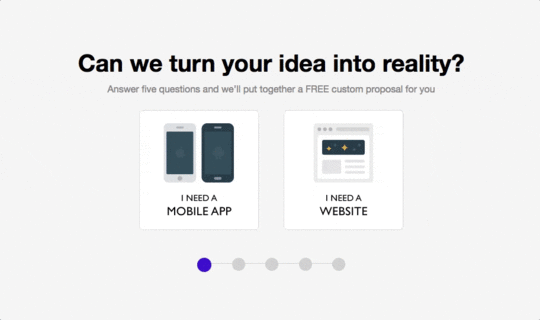
Aside from removing friction and boosting conversion rates, Leadformly‘s multistep forms allow you to score your leads based on the info they provide and then automate your follow-up messages. This has allowed us to create fully automated marketing strategies – such as our webinar and proposals automation – that generate and close leads without any input from us at all.
Social media: Edgar and Buffer

Social media posting is one of the first marketing tasks you should automate and the only two tools we need are Edgar and Buffer to manage most of our social media activity. We’re not suggesting you automate everything – for example, one-to-one interactions – but tasks like publishing posts, scheduling and reposting should all be automated.
Recruiting: Breezy

Finding great staff is always a challenge but Breezy will help you organise and manage candidates for all positions, across different stages of the interview process – much in the same way sales automation tools work.
Basic automations: Zapier
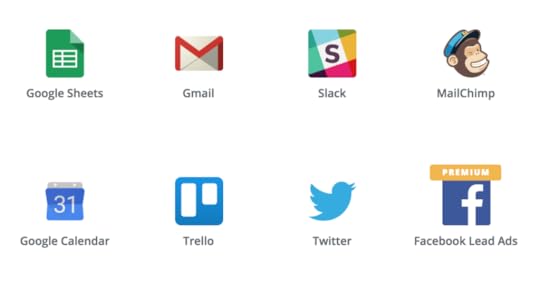
Zapier is a simple but wonderful (aka: simply wonderful) automation tool that creates mini automations between your favourite business tools. You can automate Google Calendar entries from Trello cards, add or update ActiveCampaigns contacts from Facebook and MailChimp leads and create all kinds of time-saving automation.
#3: Set your automation targets
It’s no good spending money on automation tools and investing time in creating new workflows if they don’t make your business more profitable. So before you put any workflows in place, make sure you set specific targets that you can use to gauge success and refine your processes.
In some cases, your goal might be to simpy match the performance of your team and then use that time elsewhere. For example, you may automate your social posts so that blog articles are automatically published on Twitter three times per day for a week. If your team is already doing this, automating this workflow isn’t going to improve results, it’s simply going to free up time that you can spend on other things.
The question is: what are you going to do with this time that adds value to your business? The goal of this automation is to allow you to do something else – so what is it? Define your goal and make sure it’s measurable so you can see the impact of even minor automations like these (they all add up).
For other workflows, setting goals will happen naturally. For example, when you’re creating an automated lead generation process, you’ll set a target number of leads and other KPIs while your sales automation will set targets for closing more leads and retaining more customers.
Be specific, set targets for each quarter and use these as a benchmark to gauge success.
#4: Track results and refine your processes
Without setting targets and choosing the right KPIs, you’ll struggle to measure how much of a positive impact automation is having on your business. More importantly, you won’t be able to pinpoint opportunities to refine your automations and improve results.
When automation allows you to multiply tasks almost infinitely, a simple tweak to your workflow can add thousands or even hundreds of thousands to your profit margins. Our automated webinar strategy increased leads by more than 300% in less than a year because we set our targets, measures results and optimised our processes.
That’s just one marketing automation strategy that’s made a serious impact to our business and we know we’re getting close to the best results we possibly can from it. Without tracking results and refining our workflow, we’d have no idea how much more this strategy could be adding to our annual profit margins.
#5: Create an automative culture in your workplace
Once you get to grips with automation, you’ll realise it’s a state of mind as much as a technology. You’ll look at everything and think can we automate that? and you’ll look at every existing automation you’re running and think how can we improve that?
This is the kind of automation culture you want to build in your workplace, across your entire team. This mindset is all about efficiency, making the most of your resources and maximising results with what you have – everything you want your team to be thinking about when they’re completing tasks.
You want your team members to recognise when they’re repeating the same tasks over and again, tasks that could be automated and free up more time for ones that can’t. This kind of mindset doesn’t come automatically (how ironic) so make this a constant presence in the workplace and reward your team for turning automation into better results.
Start small and build from there
As mentioned earlier, the key to automation is to start small and build your workflows over time. Implement your first processes, track results and refine your worklows for better performance before you start adding too many (or more complex) automations into the mix.
This way, the learning curve is a lot more gradual and also faster to come to terms with. Before you know it, you’ll be publishing your own blog posts bragging about how high your conversion rates are thanks to your latest automations.
The post How to Automate Your Small Business in 5 Simple Steps appeared first on Venture Harbour.
5 Steps to Transforming Your Business with Automation
Automation is taking the marketing and wider business world by storm, thanks to a new breed of mature algorithmic technology that’s available for everyone to use. Now, brands of all sizes can create their own automated processes to transform their business into a more productive, efficient and – above all – profitable enterprise.
In this article we’re going to run through the five key steps to transforming your business with automation – so you can make 2018 the year you turn this technology into end-of-year reports worth celebrating.
#1: Choose which tasks you’re going to automate
If this sounds obvious or simple, think again. Choosing the right tasks to automate is absolutely crucial and this is where most businesses get off to a false start with automation – so don’t make the same mistake.
First, you need to understand how automation works and what it’s truly capable of because the majority of tasks you can automate, you probably shouldn’t. There are tonnes of tools for automating translation, web design, content writing and everything else you could do as a marketer or business owner – but most of them fall way short of the mark.
Translation technology, for example, is basically useless for most business purposes and it’s difficult to know whether the technology will ever be able to replicate the complex cognitive processes human translators are capable of.
So what kind of tasks should you be automating?
Well, you want to automate tasks that are repetitive, time-consuming and easy for algorithms to handle 100% accurately without your input. Tasks like:
Publishing WordPress posts to Twitter at specific times
Bulk image resizing and optimisation
Analytics reports
Sending invoices once tasks are completed
Scoring leads based on user actions
Automating email responses for different lead scores
Reaching out to existing customer
What you don’t want to try and automate are tasks that require creative thinking and a lot of human input – ie: content creation, design processes or problem solving. Start simple by connecting platforms together with tools like Zapier and IFTTT and aim to take out as many repetitive tasks out of your workflow as possible.
For example, do you really need to import spreadsheets between Excel and Google Sheets six times a day when you could automate this process?
Once you get a feel for what automation can/can’t do you’ll start to come up with some more ambitious strategies that don’t simply save you time and money but transform your business entirely. Before long, you’ll be writing success stories like these:
12 Automation Tools That Save Us £155,000+ on Extra Staff & Freelancers Every Year
Growth on Autopilot: A Healthier Alternative to the Old Way of Business
How to Automate Quotes & Proposals to Capture More Leads
The Ultimate Guide to Automated Evergreen Webinars
#2: Choose your automation tools
Once you know which tasks you’re going to automate, it’s time to choose the tools you’re going to use to make things happen. There are so many automation platforms available now that it’s difficult to know where to begin – so here are some recommendations for the most common business automation tasks:
Sales automation: ActiveCampaign

For an all-in-one marketing and sales automation tool, ActiveCampaign is the place to start transforming your business. Bring your marketing and sales teams together, cut out repetitive tasks and manage your customers as they navigate their way through different stages of the buying process.
ActiveCampaign Review: How we Automate Sales, Marketing & More
Lead scoring: Leadformly

Aside from removing friction and boosting conversion rates, Leadformly‘s multistep forms allow you to score your leads based on the info they provide and then automate your follow-up messages. This has allowed us to create fully automated marketing strategies – such as our webinar and proposals automation – that generate and close leads without any input from us at all.
Social media: Edgar and Buffer

Social media posting is one of the first marketing tasks you should automate and the only two tools we need are Edgar and Buffer to manage most of our social media activity. We’re not suggesting you automate everything – for example, one-to-one interactions – but tasks like publishing posts, scheduling and reposting should all be automated.
Recruiting: Breezy

Finding great staff is always a challenge but Breezy will help you organise and manage candidates for all positions, across different stages of the interview process – much in the same way sales automation tools work.
Basic automations: Zapier

Zapier is a simple but wonderful (aka: simply wonderful) automation tool that creates mini automations between your favourite business tools. You can automate Google Calendar entries from Trello cards, add or update ActiveCampaigns contacts from Facebook and MailChimp leads and create all kinds of time-saving automation.
#3: Set your automation targets
It’s no good spending money on automation tools and investing time in creating new workflows if they don’t make your business more profitable. So before you put any workflows in place, make sure you set specific targets that you can use to gauge success and refine your processes.
In some cases, your goal might be to simpy match the performance of your team and then use that time elsewhere. For example, you may automate your social posts so that blog articles are automatically published on Twitter three times per day for a week. If your team is already doing this, automating this workflow isn’t going to improve results, it’s simply going to free up time that you can spend on other things.
The question is: what are you going to do with this time that adds value to your business? The goal of this automation is to allow you to do something else – so what is it? Define your goal and make sure it’s measurable so you can see the impact of even minor automations like these (they all add up).
For other workflows, setting goals will happen naturally. For example, when you’re creating an automated lead generation process, you’ll set a target number of leads and other KPIs while your sales automation will set targets for closing more leads and retaining more customers.
Be specific, set targets for each quarter and use these as a benchmark to gauge success.
#4: Track results and refine your processes
Without setting targets and choosing the right KPIs, you’ll struggle to measure how much of a positive impact automation is having on your business. More importantly, you won’t be able to pinpoint opportunities to refine your automations and improve results.
When automation allows you to multiply tasks almost infinitely, a simple tweak to your workflow can add thousands or even hundreds of thousands to your profit margins. Our automated webinar strategy increased leads by more than 300% in less than a year because we set our targets, measures results and optimised our processes.
That’s just one marketing automation strategy that’s made a serious impact to our business and we know we’re getting close to the best results we possibly can from it. Without tracking results and refining our workflow, we’d have no idea how much more this strategy could be adding to our annual profit margins.
#5: Create an automative culture in your workplace
Once you get to grips with automation, you’ll realise it’s a state of mind as much as a technology. You’ll look at everything and think can we automate that? and you’ll look at every existing automation you’re running and think how can we improve that?
This is the kind of automation culture you want to build in your workplace, across your entire team. This mindset is all about efficiency, making the most of your resources and maximising results with what you have – everything you want your team to be thinking about when they’re completing tasks.
You want your team members to recognise when they’re repeating the same tasks over and again, tasks that could be automated and free up more time for ones that can’t. This kind of mindset doesn’t come automatically (how ironic) so make this a constant presence in the workplace and reward your team for turning automation into better results.
Start small and build from there
As mentioned earlier, the key to automation is to start small and build your workflows over time. Implement your first processes, track results and refine your worklows for better performance before you start adding too many (or more complex) automations into the mix.
This way, the learning curve is a lot more gradual and also faster to come to terms with. Before you know it, you’ll be publishing your own blog posts bragging about how high your conversion rates are thanks to your latest automations.
The post 5 Steps to Transforming Your Business with Automation appeared first on Venture Harbour.
May 20, 2018
12 Marketing Automation Tools That Saved us £155,000+ on Social Media & Lead Gen
Marketing automation has reached maturity over the past few years, allowing businesses in every industry to do more for less. Here at Venture Harbour, we’ve transformed the way we operate thanks to automation and now we’re doing the same for our clients using the technology to boost productivity and reduce expenses.
With a relatively simple combination of 12 different automation tools, we’re saving more than £155,000 every year on wages alone.
That’s not all, either. Aside from saving us money, our automation system allows us to generate more business and turn over, boosting our profit margin while also saving us a healthy sum in the same process.
#1: ActiveCampaign
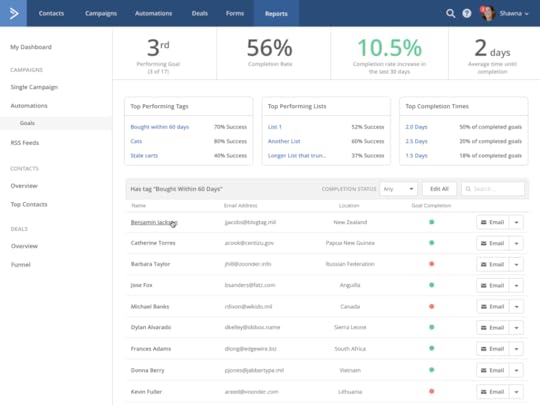
ActiveCampaign is a powerful marketing automation tool that helps us nurture leads and keep our customers happy. This takes a huge chunk out of our sales and marketing workflow – to such an extent we don’t even need a sales team and roughly half of the marketing personnel we would normally need to hire.
How much can ActiveCampaign save you?
ActiveCampaign has saved us from hiring at least two sales and marketing team members over the last few years. You can expect to pay at least £25,000 per year for each member of your sales and marketing team which means ActiveCampaign is saving us £50,000 per year before we even talk about the money it makes us in sales and lead nurturing.
#2: Webinarjam
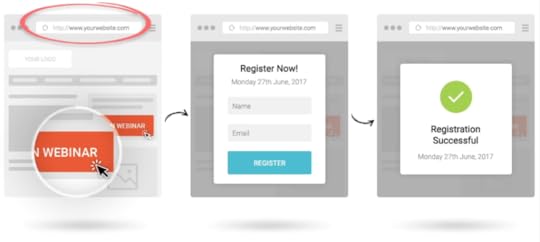
WebinarJam allows us to fully automate our webinar marketing strategy, one of our most important lead generation tactics. By creating evergreen webinar content and automating both the signup and screening processes, we can generate leads around the clock without doing anything after the initial setup. Better yet, we can integrate this with ActiveCampaign to automate our follow-up responses for different audiences: those who attend our webinar, those who sign up but don’t attend and those who don’t watch it in full, for example.
How much can WebinarJam save you?
WebinarJam saves us from having another sales and marketing team member from managing our webinar marketing strategy and handling the leads it generates. Actually, ActiveCampaign also helps us out here as well but we’re talking about another £25,000 saved every year in wages whichever way you look at it.
#3: Edgar

Social media is important to every modern brand and Ventrue Harbour is no exception. The problem is managing social media accounts is time-consuming and it requires enough personnel to keep all of your networks running -especially when you need to respond to user posts and comments.
Unless you use a tool like Edgar to automate your social media activity. With Edgar, you’ll never need to repeat or schedule posts again and you can even use this tool to post updates for you based on websites and blogs on your RSS feed.
Essentially, you’re creating a library of content in a folder where you can bulk edit, and delete things as they become irrelevant. Edgar automatically schedules these posts across your networks to make sure every piece of content goes as far as possible.
How much can Edgar save you?
By powering our social media efforts with Edgar and the next tool in our list (Buffer), we’ve don’t need to hire a social media manager whatsoever, which typically earn a minimum of £28,500 per year in the UK which means Edgar has to get credit for saving us at least £14,250 every year.
#4: Buffer
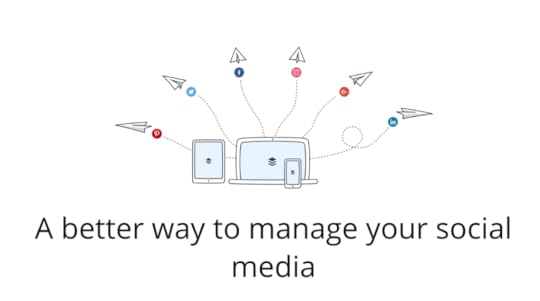
While Edgar takes the initiative and schedules your social media posts for you, there are times when you want control over when certain pieces of content. This is where Buffer comes into our social media automation strategy. With Buffer we can schedule posts across all of our social media accounts and analyse performance. This means we can identify which days and times our content is most effective on each network and automate posts to suit.
How much can Buffer save you?
Buffer gets credit for saving us the other half a social media manager’s wage which means it’s also trimming a good £14,250 from our annual expenses.
#5: GhostInspector

Every brand with a website, application or bespoke software needs to run user tests to identify bugs and improve the user experience. GhostInspector automates a number of tests, including a visual editor so you can create your own tests without coding everything from scratch. You can also record these tests in-browser, continuously monitor the functionality of your website or app and set up notifications when issues are detected.
How much can GhostInspector save you?
Our combination of debugging tools saves us from hiring at least one extra software QA team member, which earn an average of £35,504 every year in London. GhostInspector deserves credit for a quarter of the credit for this, which means we’re saving almost £9,000 every year by using this tool.
#6: Sentry

Sentry is an open source error tracking system that helps developers to monitor and fix crashes in real time, rather than wait for users to report a problem. Sentry provides all the details you need regarding errors during a user session (eg: browser versions, version of your software, error type, operating system, etc.) so you don’t need to waste time asking users for the same old information – you can focus on fixing problems faster.
How much can Sentry save you?
Sentry is our second of four software QA tools and this means another £9,000 or so saved from our annual wage bill.
#7: Codacy

Codacy is a code review and debugging platform that helps you detect problems and iron out creases before sending applications or updates live. You can apply code standards across each project and Codacy will analyse your files to highlight any inconsistencies and obvious errors. It also grades the code of your programmers and helps them to improve their skills, stick to your style guides and give them a gentle nudge if they head off in the wrong direction.
How much can Codacy save you?
That’s right, we’re looking at another £9,000 saving every year thanks to Codacy.
#8: CircleCI

CircleCI helps the likes of Spotify, GoPro and our team at Venture Harbour to automate development processes and turn great ideas into quality code faster. It allows you to create config files that control the way your software and updates are deployed across every channel. When you have multiple websites, apps or other platforms spread across different channels, this is an invaluable automation tool for new releases, updates and bug fixes.
How much can CircleCI save you?
CricleCI is the last software QA tool in this list but the £9,000 it saves us every year means it’s just as valuable to us as the rest of them.
#9: Calendly
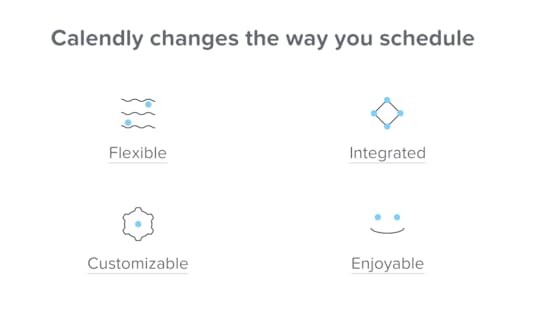
Calendly is one of those simple yet wonderful productivity tools that just about everyone should be using. No more bouncing emails back and forth to arrange meetings, confirm details or get teams together – Calendly takes care of all of this for you and invitees simply click to confirm or suggest an alternative. This is ideal if you have large teams working on projects or international workforces where time zones and national holidays make it difficult to ensure everyone is available at the same time.
How much can Calendly save you?
Calendly is one of four tools we use that saves us from hiring a part-time administrator. You can expect to pay a minimum of £16,622 per year to hire one of these and that means Calendly is saving us more than £4,000 annually.
Admittedly, Calendly probably doesn’t deserve an equal share of this saving but we’re more interested in how much all 12 of these tools have saved us in total, so we’re not going to get too stingy with our maths.
#10: Zapier

Zapier is another relatively simple productivity tool but it packs a serious punch when it comes to basic automation between different apps. For example, you can create a workflow that detects new emails landing in your Gmail inbox, copies all attachments to Dropbox and then alerts the relevant people on Slack about the new Dropbox file. There’s an almost limitless amount of workflows you can create across thousands of the most popular applications for businesses and developers, saving all kinds of time on repetitive tasks so you can concentrate on more important things.
How much can Zapier save you?
Zapier’s share of what we would have to pay for a part-time administrator means it’s saving us another £4,000+ every year.
#11: Breezy HR

Hiring great staff can be a time-consuming process and a difficult one t0 manage and Breezy HR aims to make this easier for you. Breezy allows you to create pipelines for different positions so you can monitor and manage candidates at different stages of the application process. You can create detailed profiles, score candidates, pre-screen them, manage interview guides and move your most promising candidates to the next stage using Breezy’s drag-and-drop pipelines.
How much can Breezy save you?
As the third of our four admin tools, Breezy also saves us more than £4,000 per year on wages.
#12: Xero
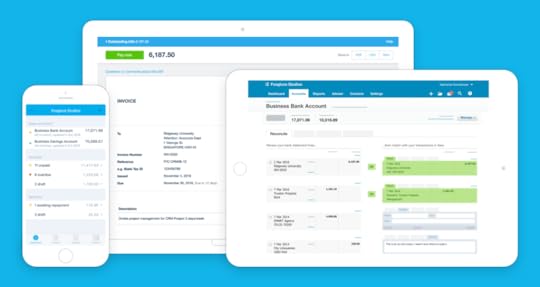
Accounting might just be the worst of all admin tasks for small businesses that simply want to concentrate on what they do best. We get it, believe me. But, sadly, there’s no getting away from the need to manage your books and Xero does its best to take as much of the pain out of accounting as possible. This cross-device platform allows you to manage accounts on the go, create and send invoices faster and deal with discrepancies in one place.
How much can Xero save you?
You guessed it; Xero also knocks a minimum of £4,000 off our annual expenses.
Total saved: £155,000+ every year
By using these 12 automation tools we’re saving at least £155,500 every year on extra staff and freelancer fees. Let’s keep in mind that the marketing automation tools are also making us money while our software QA tools are helping us improve our products and user experiences.
These tools are all adding something to Venture Harbour and saving us a good chunk of money while they’re at it. Our staffing needs are relatively modest, too, which goes to show how much larger businesses can save by using automation to improve business performance and reduce wage expenses.
The post 12 Marketing Automation Tools That Saved us £155,000+ on Social Media & Lead Gen appeared first on Venture Harbour.
12 Automation Tools That Save Us £155,000+ on Extra Staff & Freelancers Every Year
Marketing automation has reached maturity over the past few years, allowing businesses in every industry to do more for less. Here at Venture Harbour, we’ve transformed the way we operate thanks to automation and now we’re doing the same for our clients using the technology to boost productivity and reduce expenses.
With a relatively simple combination of 12 different automation tools, we’re saving more than £155,000 every year on wages alone.
That’s not all, either. Aside from saving us money, our automation system allows us to generate more business and turn over, boosting our profit margin while also saving us a healthy sum in the same process.
#1: ActiveCampaign

ActiveCampaign is a powerful marketing automation tool that helps us nurture leads and keep our customers happy. This takes a huge chunk out of our sales and marketing workflow – to such an extent we don’t even need a sales team and roughly half of the marketing personnel we would normally need to hire.
How much can ActiveCampaign save you?
ActiveCampaign has saved us from hiring at least two sales and marketing team members over the last few years. You can expect to pay at least £25,000 per year for each member of your sales and marketing team which means ActiveCampaign is saving us £50,000 per year before we even talk about the money it makes us in sales and lead nurturing.
#2: Webinarjam

WebinarJam allows us to fully automate our webinar marketing strategy, one of our most important lead generation tactics. By creating evergreen webinar content and automating both the signup and screening processes, we can generate leads around the clock without doing anything after the initial setup. Better yet, we can integrate this with ActiveCampaign to automate our follow-up responses for different audiences: those who attend our webinar, those who sign up but don’t attend and those who don’t watch it in full, for example.
How much can WebinarJam save you?
WebinarJam saves us from having another sales and marketing team member from managing our webinar marketing strategy and handling the leads it generates. Actually, ActiveCampaign also helps us out here as well but we’re talking about another £25,000 saved every year in wages whichever way you look at it.
#3: Edgar

Social media is important to every modern brand and Ventrue Harbour is no exception. The problem is managing social media accounts is time-consuming and it requires enough personnel to keep all of your networks running -especially when you need to respond to user posts and comments.
Unless you use a tool like Edgar to automate your social media activity. With Edgar, you’ll never need to repeat or schedule posts again and you can even use this tool to post updates for you based on websites and blogs on your RSS feed.
Essentially, you’re creating a library of content in a folder where you can bulk edit, and delete things as they become irrelevant. Edgar automatically schedules these posts across your networks to make sure every piece of content goes as far as possible.
How much can Edgar save you?
By powering our social media efforts with Edgar and the next tool in our list (Buffer), we’ve don’t need to hire a social media manager whatsoever, which typically earn a minimum of £28,500 per year in the UK which means Edgar has to get credit for saving us at least £14,250 every year.
#4: Buffer

While Edgar takes the initiative and schedules your social media posts for you, there are times when you want control over when certain pieces of content. This is where Buffer comes into our social media automation strategy. With Buffer we can schedule posts across all of our social media accounts and analyse performance. This means we can identify which days and times our content is most effective on each network and automate posts to suit.
How much can Buffer save you?
Buffer gets credit for saving us the other half a social media manager’s wage which means it’s also trimming a good £14,250 from our annual expenses.
#5: GhostInspector

Every brand with a website, application or bespoke software needs to run user tests to identify bugs and improve the user experience. GhostInspector automates a number of tests, including a visual editor so you can create your own tests without coding everything from scratch. You can also record these tests in-browser, continuously monitor the functionality of your website or app and set up notifications when issues are detected.
How much can GhostInspector save you?
Our combination of debugging tools saves us from hiring at least one extra software QA team member, which earn an average of £35,504 every year in London. GhostInspector deserves credit for a quarter of the credit for this, which means we’re saving almost £9,000 every year by using this tool.
#6: Sentry

Sentry is an open source error tracking system that helps developers to monitor and fix crashes in real time, rather than wait for users to report a problem. Sentry provides all the details you need regarding errors during a user session (eg: browser versions, version of your software, error type, operating system, etc.) so you don’t need to waste time asking users for the same old information – you can focus on fixing problems faster.
How much can Sentry save you?
Sentry is our second of four software QA tools and this means another £9,000 or so saved from our annual wage bill.
#7: Codacy

Codacy is a code review and debugging platform that helps you detect problems and iron out creases before sending applications or updates live. You can apply code standards across each project and Codacy will analyse your files to highlight any inconsistencies and obvious errors. It also grades the code of your programmers and helps them to improve their skills, stick to your style guides and give them a gentle nudge if they head off in the wrong direction.
How much can Codacy save you?
That’s right, we’re looking at another £9,000 saving every year thanks to Codacy.
#8: CircleCI

CircleCI helps the likes of Spotify, GoPro and our team at Venture Harbour to automate development processes and turn great ideas into quality code faster. It allows you to create config files that control the way your software and updates are deployed across every channel. When you have multiple websites, apps or other platforms spread across different channels, this is an invaluable automation tool for new releases, updates and bug fixes.
How much can CircleCI save you?
CricleCI is the last software QA tool in this list but the £9,000 it saves us every year means it’s just as valuable to us as the rest of them.
#9: Calendly

Calendly is one of those simple yet wonderful productivity tools that just about everyone should be using. No more bouncing emails back and forth to arrange meetings, confirm details or get teams together – Calendly takes care of all of this for you and invitees simply click to confirm or suggest an alternative. This is ideal if you have large teams working on projects or international workforces where time zones and national holidays make it difficult to ensure everyone is available at the same time.
How much can Calendly save you?
Calendly is one of four tools we use that saves us from hiring a part-time administrator. You can expect to pay a minimum of £16,622 per year to hire one of these and that means Calendly is saving us more than £4,000 annually.
Admittedly, Calendly probably doesn’t deserve an equal share of this saving but we’re more interested in how much all 12 of these tools have saved us in total, so we’re not going to get too stingy with our maths.
#10: Zapier

Zapier is another relatively simple productivity tool but it packs a serious punch when it comes to basic automation between different apps. For example, you can create a workflow that detects new emails landing in your Gmail inbox, copies all attachments to Dropbox and then alerts the relevant people on Slack about the new Dropbox file. There’s an almost limitless amount of workflows you can create across thousands of the most popular applications for businesses and developers, saving all kinds of time on repetitive tasks so you can concentrate on more important things.
How much can Zapier save you?
Zapier’s share of what we would have to pay for a part-time administrator means it’s saving us another £4,000+ every year.
#11: Breezy HR

Hiring great staff can be a time-consuming process and a difficult one t0 manage and Breezy HR aims to make this easier for you. Breezy allows you to create pipelines for different positions so you can monitor and manage candidates at different stages of the application process. You can create detailed profiles, score candidates, pre-screen them, manage interview guides and move your most promising candidates to the next stage using Breezy’s drag-and-drop pipelines.
How much can Breezy save you?
As the third of our four admin tools, Breezy also saves us more than £4,000 per year on wages.
#12: Xero

Accounting might just be the worst of all admin tasks for small businesses that simply want to concentrate on what they do best. We get it, believe me. But, sadly, there’s no getting away from the need to manage your books and Xero does its best to take as much of the pain out of accounting as possible. This cross-device platform allows you to manage accounts on the go, create and send invoices faster and deal with discrepancies in one place.
How much can Xero save you?
You guessed it; Xero also knocks a minimum of £4,000 off our annual expenses.
Total saved: £155,000+ every year
By using these 12 automation tools we’re saving at least £155,500 every year on extra staff and freelancer fees. Let’s keep in mind that the marketing automation tools are also making us money while our software QA tools are helping us improve our products and user experiences.
These tools are all adding something to Venture Harbour and saving us a good chunk of money while they’re at it. Our staffing needs are relatively modest, too, which goes to show how much larger businesses can save by using automation to improve business performance and reduce wage expenses.
The post 12 Automation Tools That Save Us £155,000+ on Extra Staff & Freelancers Every Year appeared first on Venture Harbour.
12 Automation Tools Save Us £155,000+ on Extra Staff & Freelancers Every Year
Marketing automation has reached maturity over the past few years, allowing businesses in every industry to do more for less. Here at Venture Harbour, we’ve transformed the way we operate thanks to automation and now we’re doing the same for our clients using the technology to boost productivity and reduce expenses.
With a relatively simple combination of 12 different automation tools, we’re saving more than £155,000 every year on wages alone.
That’s not all, either. Aside from saving us money, our automation system allows us to generate more business and turn over, boosting our profit margin while also saving us a healthy sum in the same process.
#1: ActiveCampaign

ActiveCampaign is a powerful marketing automation tool that helps us nurture leads and keep our customers happy. This takes a huge chunk out of our sales and marketing workflow – to such an extent we don’t even need a sales team and roughly half of the marketing personnel we would normally need to hire.
How much can ActiveCampaign save you?
ActiveCampaign has saved us from hiring at least two sales and marketing team members over the last few years. You can expect to pay at least £25,000 per year for each member of your sales and marketing team which means ActiveCampaign is saving us £50,000 per year before we even talk about the money it makes us in sales and lead nurturing.
#2: Webinarjam

WebinarJam allows us to fully automate our webinar marketing strategy, one of our most important lead generation tactics. By creating evergreen webinar content and automating both the signup and screening processes, we can generate leads around the clock without doing anything after the initial setup. Better yet, we can integrate this with ActiveCampaign to automate our follow-up responses for different audiences: those who attend our webinar, those who sign up but don’t attend and those who don’t watch it in full, for example.
How much can WebinarJam save you?
WebinarJam saves us from having another sales and marketing team member from managing our webinar marketing strategy and handling the leads it generates. Actually, ActiveCampaign also helps us out here as well but we’re talking about another £25,000 saved every year in wages whichever way you look at it.
#3: Edgar

Social media is important to every modern brand and Ventrue Harbour is no exception. The problem is managing social media accounts is time-consuming and it requires enough personnel to keep all of your networks running -especially when you need to respond to user posts and comments.
Unless you use a tool like Edgar to automate your social media activity. With Edgar, you’ll never need to repeat or schedule posts again and you can even use this tool to post updates for you based on websites and blogs on your RSS feed.
Essentially, you’re creating a library of content in a folder where you can bulk edit, and delete things as they become irrelevant. Edgar automatically schedules these posts across your networks to make sure every piece of content goes as far as possible.
How much can Edgar save you?
By powering our social media efforts with Edgar and the next tool in our list (Buffer), we’ve don’t need to hire a social media manager whatsoever, which typically earn a minimum of £28,500 per year in the UK which means Edgar has to get credit for saving us at least £14,250 every year.
#4: Buffer

While Edgar takes the initiative and schedules your social media posts for you, there are times when you want control over when certain pieces of content. This is where Buffer comes into our social media automation strategy. With Buffer we can schedule posts across all of our social media accounts and analyse performance. This means we can identify which days and times our content is most effective on each network and automate posts to suit.
How much can Buffer save you?
Buffer gets credit for saving us the other half a social media manager’s wage which means it’s also trimming a good £14,250 from our annual expenses.
#5: GhostInspector

Every brand with a website, application or bespoke software needs to run user tests to identify bugs and improve the user experience. GhostInspector automates a number of tests, including a visual editor so you can create your own tests without coding everything from scratch. You can also record these tests in-browser, continuously monitor the functionality of your website or app and set up notifications when issues are detected.
How much can GhostInspector save you?
Our combination of debugging tools saves us from hiring at least one extra software QA team member, which earn an average of £35,504 every year in London. GhostInspector deserves credit for a quarter of the credit for this, which means we’re saving almost £9,000 every year by using this tool.
#6: Sentry

Sentry is an open source error tracking system that helps developers to monitor and fix crashes in real time, rather than wait for users to report a problem. Sentry provides all the details you need regarding errors during a user session (eg: browser versions, version of your software, error type, operating system, etc.) so you don’t need to waste time asking users for the same old information – you can focus on fixing problems faster.
How much can Sentry save you?
Sentry is our second of four software QA tools and this means another £9,000 or so saved from our annual wage bill.
#7: Codacy

Codacy is a code review and debugging platform that helps you detect problems and iron out creases before sending applications or updates live. You can apply code standards across each project and Codacy will analyse your files to highlight any inconsistencies and obvious errors. It also grades the code of your programmers and helps them to improve their skills, stick to your style guides and give them a gentle nudge if they head off in the wrong direction.
How much can Codacy save you?
That’s right, we’re looking at another £9,000 saving every year thanks to Codacy.
#8: CircleCI

CircleCI helps the likes of Spotify, GoPro and our team at Venture Harbour to automate development processes and turn great ideas into quality code faster. It allows you to create config files that control the way your software and updates are deployed across every channel. When you have multiple websites, apps or other platforms spread across different channels, this is an invaluable automation tool for new releases, updates and bug fixes.
How much can CircleCI save you?
CricleCI is the last software QA tool in this list but the £9,000 it saves us every year means it’s just as valuable to us as the rest of them.
#9: Calendly

Calendly is one of those simple yet wonderful productivity tools that just about everyone should be using. No more bouncing emails back and forth to arrange meetings, confirm details or get teams together – Calendly takes care of all of this for you and invitees simply click to confirm or suggest an alternative. This is ideal if you have large teams working on projects or international workforces where time zones and national holidays make it difficult to ensure everyone is available at the same time.
How much can Calendly save you?
Calendly is one of four tools we use that saves us from hiring a part-time administrator. You can expect to pay a minimum of £16,622 per year to hire one of these and that means Calendly is saving us more than £4,000 annually.
Admittedly, Calendly probably doesn’t deserve an equal share of this saving but we’re more interested in how much all 12 of these tools have saved us in total, so we’re not going to get too stingy with our maths.
#10: Zapier

Zapier is another relatively simple productivity tool but it packs a serious punch when it comes to basic automation between different apps. For example, you can create a workflow that detects new emails landing in your Gmail inbox, copies all attachments to Dropbox and then alerts the relevant people on Slack about the new Dropbox file. There’s an almost limitless amount of workflows you can create across thousands of the most popular applications for businesses and developers, saving all kinds of time on repetitive tasks so you can concentrate on more important things.
How much can Zapier save you?
Zapier’s share of what we would have to pay for a part-time administrator means it’s saving us another £4,000+ every year.
#11: Breezy HR

Hiring great staff can be a time-consuming process and a difficult one t0 manage and Breezy HR aims to make this easier for you. Breezy allows you to create pipelines for different positions so you can monitor and manage candidates at different stages of the application process. You can create detailed profiles, score candidates, pre-screen them, manage interview guides and move your most promising candidates to the next stage using Breezy’s drag-and-drop pipelines.
How much can Breezy save you?
As the third of our four admin tools, Breezy also saves us more than £4,000 per year on wages.
#12: Xero

Accounting might just be the worst of all admin tasks for small businesses that simply want to concentrate on what they do best. We get it, believe me. But, sadly, there’s no getting away from the need to manage your books and Xero does its best to take as much of the pain out of accounting as possible. This cross-device platform allows you to manage accounts on the go, create and send invoices faster and deal with discrepancies in one place.
How much can Xero save you?
You guessed it; Xero also knocks a minimum of £4,000 off our annual expenses.
Total saved: £155,000+ every year
By using these 12 automation tools we’re saving at least £155,500 every year on extra staff and freelancer fees. Let’s keep in mind that the marketing automation tools are also making us money while our software QA tools are helping us improve our products and user experiences.
These tools are all adding something to Venture Harbour and saving us a good chunk of money while they’re at it. Our staffing needs are relatively modest, too, which goes to show how much larger businesses can save by using automation to improve business performance and reduce wage expenses.
The post 12 Automation Tools Save Us £155,000+ on Extra Staff & Freelancers Every Year appeared first on Venture Harbour.

